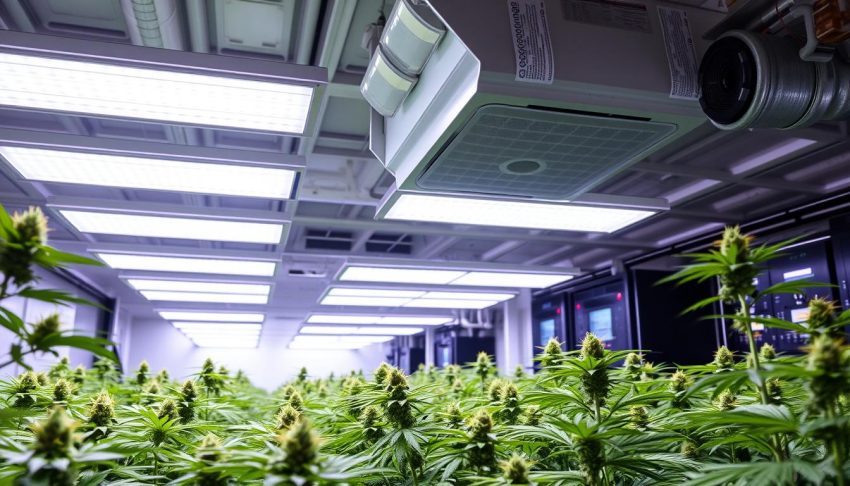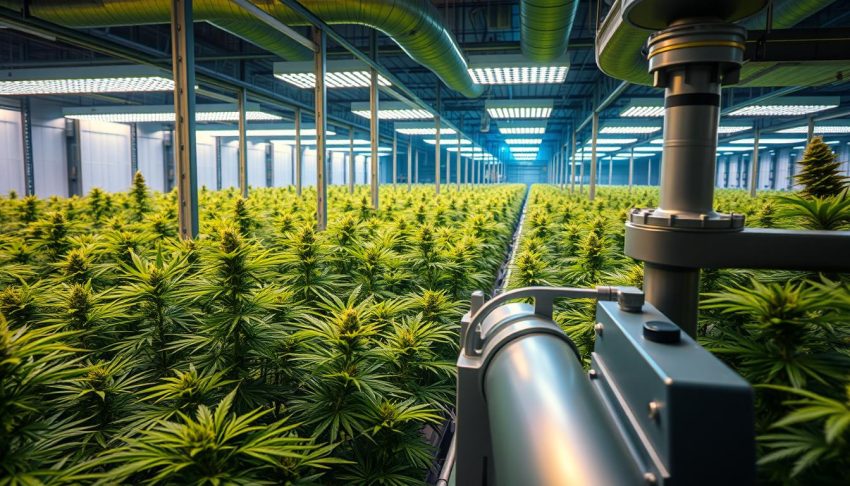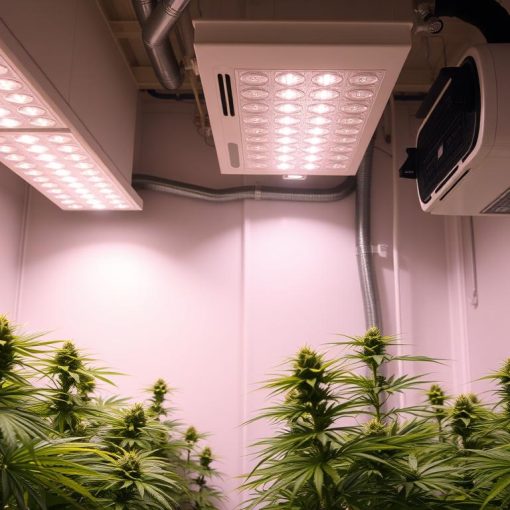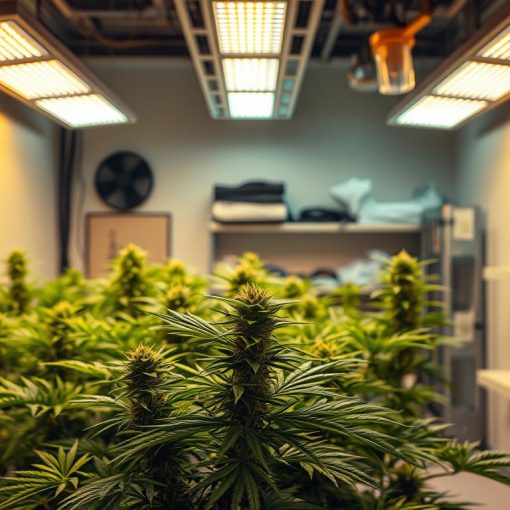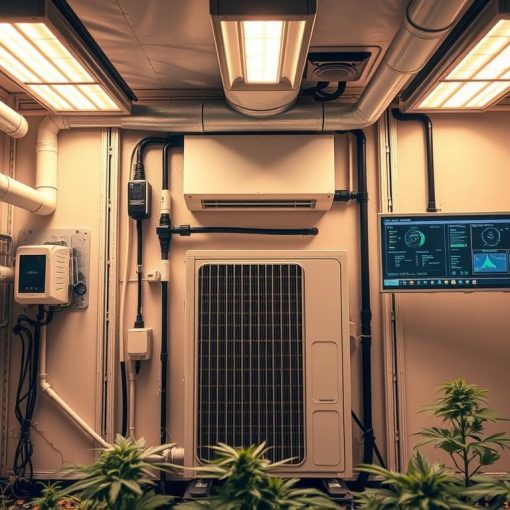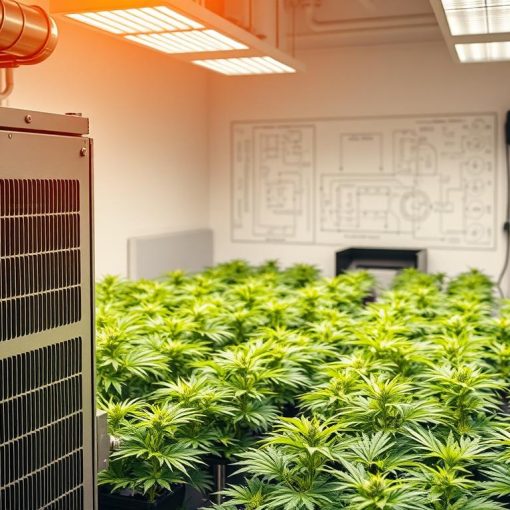Cannabis growers know how key a perfect environment is for their plants. HVAC systems are vital in creating this ideal space. They help control temperature, humidity, and airflow, leading to better yields and healthier plants. This is especially true in controlled environment agriculture, where exact control is crucial.
In the U.S., more growers are seeing the value of specialized HVAC systems. They use the latest in controlled environment agriculture to optimize their grow spaces. This leads to more plants and lower energy bills, showing how important HVAC systems are in cannabis growing.
Introduction to Cannabis HVAC
Cannabis HVAC systems manage temperature, humidity, and airflow with precision. They are key to any successful grow operation. In controlled environment agriculture, they help create the perfect space for plants to thrive. As the cannabis industry grows, so will the need for these specialized systems.
Key Takeaways
- Specialized cannabis hvac systems can boost yields and improve plant health
- Cannabis grow operations require precise control over temperature, humidity, and airflow
- Controlled environment agriculture relies heavily on advanced cannabis hvac systems
- Investing in a customized cannabis hvac solution can reduce energy costs
- Cannabis hvac systems are essential for creating an ideal environment for plant growth
- Advanced cannabis hvac systems can help growers achieve superior yields and healthier plants
Understanding Cannabis HVAC Systems Fundamentals
Cannabis growers know how crucial it is to create the best environment for their plants. This is where dhvac systems play a key role. They control temperature and humidity for the plants’ growth. Energy-efficient hvac systems are especially important in indoor cannabis farming. They help save energy while keeping the environment perfect for plant health.
Designing an hvac system for cannabis cultivation involves several important factors. These include temperature control, humidity management, and air circulation. Balancing these elements helps growers create a healthy environment for their plants. This environment promotes healthy growth and increases yields.
Some key components of a cannabis-specific hvac system include:
- Heating and cooling systems
- Dehumidification and humidification systems
- Air filtration and purification systems
These components work together to keep a stable and optimal environment for cannabis plants. This is vital for indoor cannabis farming.
Investing in a well-designed dhvac system ensures plants get the best conditions for growth. This leads to higher yields and better quality crops. Energy-efficient hvac systems are a smart choice for indoor cannabis farming. They save costs in the long run and reduce the facility’s carbon footprint.
Temperature Management for Optimal Growth
In controlled environment agriculture, temperature is key for plant growth. Keeping the right temperature is vital for healthy plants in cannabis grow operations. Knowing the temperature needs at each growth stage helps growers set up the best HVAC systems for their plants.
Here are some key considerations for temperature management in cannabis grow operations:
- Seedlings and clones need a temperature of 65-75°F (18-24°C) for healthy roots.
- Vegetative growth needs a temperature of 65-75°F (18-24°C) for leaf growth.
- Flowering and fruiting need a temperature of 65-70°F (18-21°C) for bud development.
Temperature changes can greatly affect plant growth. A 5-10°F (3-6°C) change can hurt the plant’s water and nutrient absorption. This can lead to less growth and lower yields.
In a controlled environment agriculture setting, managing temperature is crucial for the best growth and yields in cannabis grow operations. By knowing the temperature needs at each growth stage and using effective strategies, growers can create the perfect environment for their plants to flourish.
Humidity Control and Vapor Pressure Deficit
Humidity is key in indoor cannabis farming. It affects plant health and growth. Keeping humidity levels right is crucial to avoid mold and mildew. These issues can harm crop yields.
Understanding humidity control and vapor pressure deficit helps growers. They can then use dehumidification strategies to keep plants healthy.
In an energy-efficient hvac system, controlling humidity is vital. It helps plants grow well and avoids moisture problems. Growers use dehumidifiers, humidifiers, and other tools for this.
- Keep humidity levels between 40-60%
- Watch temperature and humidity to avoid vapor pressure deficit
- Use energy-efficient hvac systems to control humidity and temperature
Effective humidity control helps growers create the best environment for plants. It also saves energy and supports sustainable indoor cannabis farming practices.
Air Circulation and CO2 Enrichment
In industrial cannabis cultivation, air circulation and CO2 enrichment are key. They help plants grow well and increase yields. Cannabis hvac systems ensure the air moves right, stopping fungal diseases and helping roots grow strong.
Some benefits of air circulation in cannabis cultivation include:
- Prevention of fungal diseases
- Promotion of healthy root development
- Enhancement of CO2 absorption
CO2 enrichment is also vital for cannabis plants. It boosts yields and supports healthy growth. Growers can use CO2 enrichment in their cannabis hvac systems to create the best environment for their plants.
Growers can improve their industrial cannabis cultivation by focusing on air circulation and CO2 enrichment. This helps them design better strategies for their operations and enhance plant growth.
Specialized Cannabis HVAC System Design
Designing a cannabis HVAC system requires careful thought. The aim is to create a system that supports plant growth efficiently. dhvac systems are a good choice because they offer control and flexibility. By picking the right equipment and considering zoning, growers can make an efficient HVAC system.
Important factors in designing a cannabis HVAC system include:
- Selecting equipment made for cannabis cultivation
- Designing with zoning for even temperature and humidity
- Integrating with existing systems to save energy
Growers can create an ideal environment for plants by designing a thoughtful HVAC system. Energy-efficient hvac systems cut down on energy costs and environmental impact. With the right design and equipment, growers can make their HVAC system work best.
Growers can make a cannabis HVAC system that supports plant health and reduces waste. With the right design and equipment, dhvac systems are valuable for growers. By thinking about zoning and integration, growers can tailor their system to their needs.
Energy Efficiency and Cost Management
In cannabis grow operations, saving energy is key to cutting costs and boosting profits. Growers can do this by using energy-saving methods. For example, LED grow lights use less power than old lighting systems.
In controlled environment agriculture, saving energy is also vital. Growers can cut down on energy use by designing their facilities better. This includes using insulation, double-glazed windows, and energy-saving HVAC systems. They can also use smart controls to watch and tweak their energy use as they go.
Here are some tips for saving energy in cannabis grow operations:
- Choose energy-saving equipment, like LED grow lights and efficient HVAC systems
- Make your grow facility design better, with insulation and double-glazed windows
- Use smart controls to keep an eye on and adjust energy use
- Do regular energy audits to find ways to save more
By following these tips, cannabis growers can use less energy, save money, and make more profit. This helps their business grow and makes the cannabis industry more eco-friendly.
Common HVAC Challenges in Cannabis Cultivation
Indoor cannabis farming and industrial cannabis cultivation need precise control over the environment. This ensures optimal plant growth. However, several common HVAC challenges can arise, affecting the overall yield and quality of the crop. One of the primary concerns is maintaining a balanced environment that prevents microbial growth, manages peak load demands, and troubleshoots common issues.
In indoor cannabis farming, microbial growth can be a significant problem. It leads to reduced plant health and decreased yields. To prevent this, growers must ensure proper air circulation, maintain optimal temperature and humidity levels, and implement regular cleaning and sanitation protocols. Industrial cannabis cultivation facilities must also prioritize these factors to prevent the spread of disease and maintain a healthy growing environment.
Some common challenges in HVAC systems for cannabis cultivation include:
- Maintaining optimal temperature and humidity levels
- Managing peak load demands during extreme weather conditions
- Troubleshooting common issues, such as equipment failures or air leaks
By understanding and addressing these challenges, growers can optimize their HVAC systems. This creates an ideal environment for their plants, resulting in higher yields and better quality crops. Regular maintenance, monitoring, and troubleshooting are essential to prevent issues and ensure a smooth operation in indoor cannabis farming and industrial cannabis cultivation.
Maintenance and Performance Optimization
Regular maintenance is key to keeping cannabis hvac systems running well. This includes cleaning and replacing filters, coils, and drain lines. These steps help avoid problems like poor airflow and high energy use.
It’s also vital to watch how the system performs. Track things like temperature, humidity, and CO2 levels. This way, growers can spot issues early and tweak the system for better performance. For instance, if the temperature keeps going up, it might mean the cooling system needs a check.
Improving dhvac system performance also means designing and installing it right. Choose the right gear for your growing space and make sure the system fits. Plus, linking the hvac with lighting and irrigation systems can make growing more efficient.
- Regularly check the system for wear and tear
- Do routine maintenance like filter cleaning and replacement
- Keep an eye on system performance and adjust as needed
- Make sure the system is well-designed and installed
- Link the hvac with other control systems
By following these tips, growers can keep their systems running smoothly. This leads to healthier plants and bigger harvests.
Conclusion: Maximizing Your Cannabis Growing Success Through Advanced HVAC Solutions
Starting your cannabis grow operations? Investing in a custom, energy-saving HVAC system is key. It helps you get the best yields and keeps your growing space healthy. By knowing how HVAC creates perfect growing conditions, you can take your cannabis growing to new levels.
We’ve looked at the main parts of cannabis HVAC systems, how to manage temperature and humidity, and how to improve air and CO2. Using these tips, you can create a perfect space for your plants. This ensures they grow as well as they can.
Choosing energy-efficient HVAC systems is good for your plants and your wallet. It makes your cannabis growing more eco-friendly and profitable. With the knowledge from this guide, you’re ready to pick the best HVAC solutions for your growing needs.

